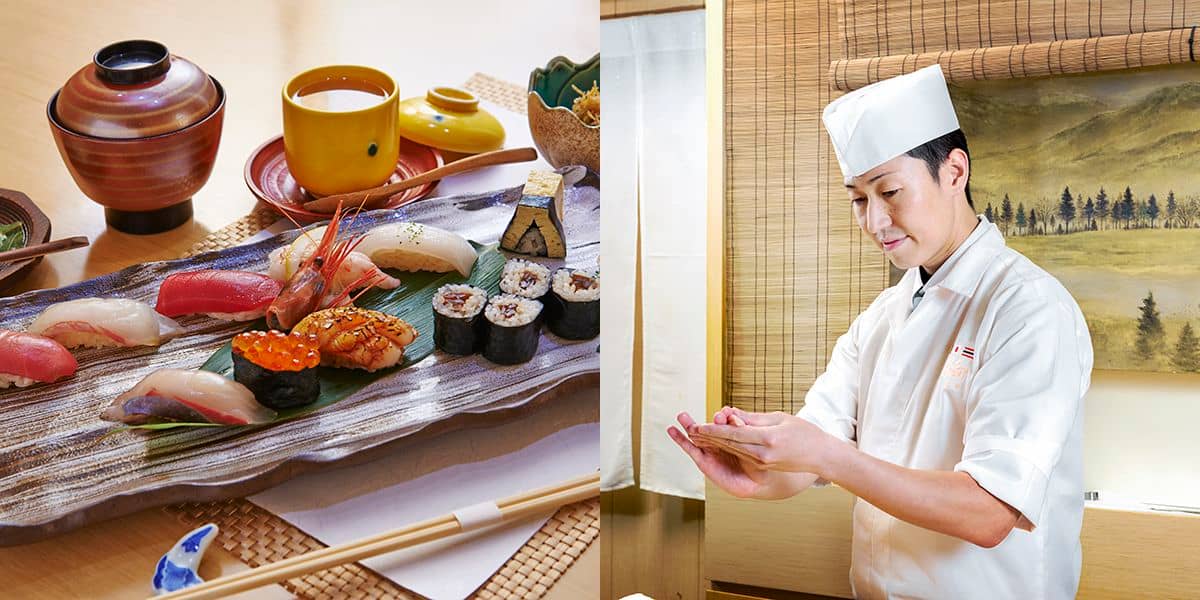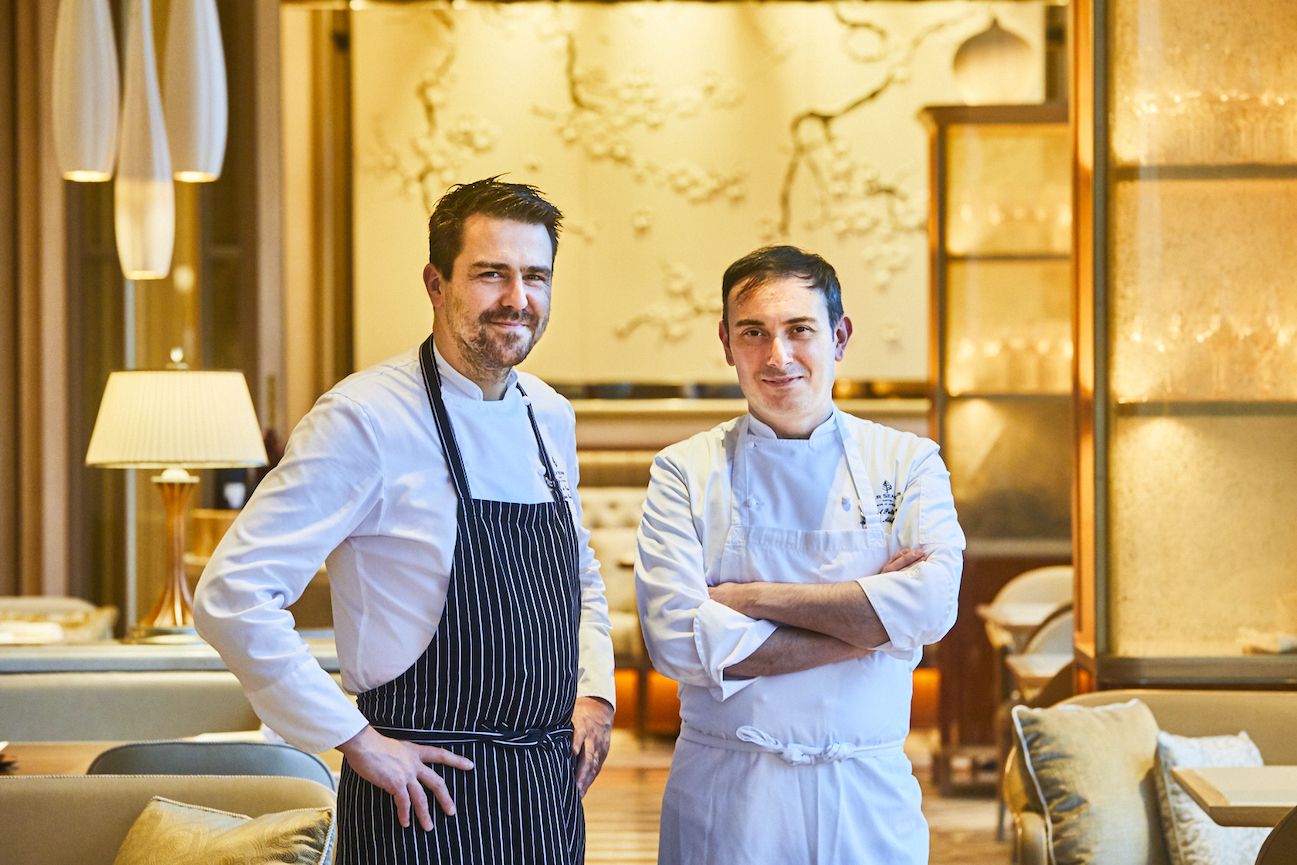
Reinterpreting Japanese customs in French cuisine, and transforming ingredients produced in Japan into surprising flavors
The abundant woodland encompassing the clusters of high-rise buildings of Otemachi and the Imperial Palace. From the French Restaurant “est” on the 39th floor of “Four Seasons Hotel Tokyo Otemachi” opened in September 2020, you have a sweeping view of the beautiful scenery of Tokyo.
“We were awarded a Michelin Star just the other day”.
French chef, Guillaume Bracaval, slowly stirring a red wine sauce in the open kitchen, has a smile on his lips. What you might call his collaborator, Italian pastry chef, Michele Abbatemarco is next to him, smiling in a similar way.
Both Guillaume and Michele spent seven and a half years together at the Japan outlet of the famous French restaurant, “Troisgros”. “Troisgros” is a famous restaurant in Roanne, France that was awarded three Michelin Stars annually for 50 years, so this star must have been very happy news for the pair. Guillaume, who apparently came to Japan in adoration of Japanese cuisine, says that he was astounded by fish markets he visited with a Japanese chef in his previous work.
“I was amazed by the number of species of fish in the catch, and by the quality. I witnessed the passion of the producers performing ikejime (bleeding), keeping the fish alive during transportation, etc., something I had never encountered in France. The Japan I adored had a food culture stretching far beyond my imagination”.
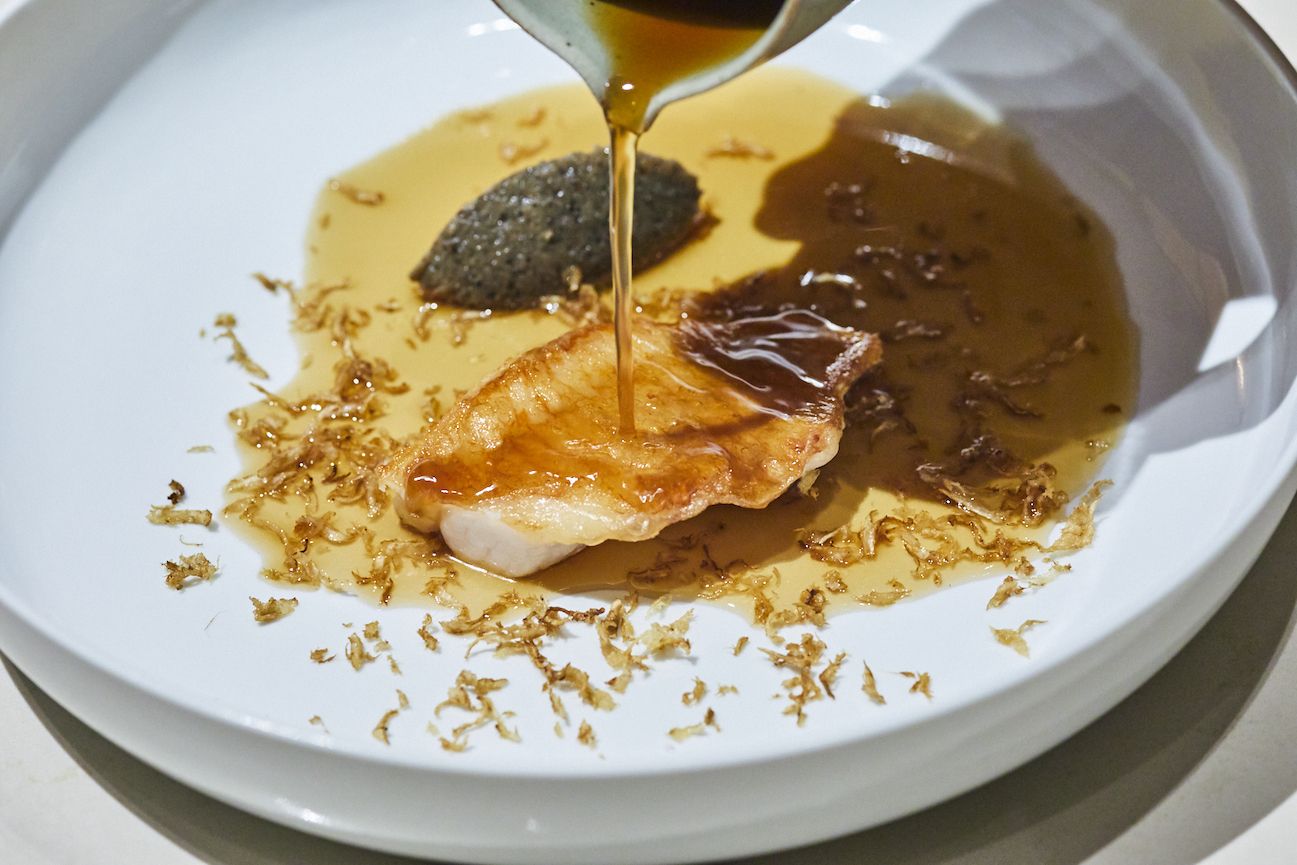
Channel rockfish, salted and dried overnight, is steamed, and grilled until just the surface is crispy. Served covered in broth using burdock root and kinoko mushroom. Accompanied by burdock root and shallot tapenade.
The fish dish of channel rockfish from Hokkaido, salted and dried overnight as in Japanese cuisine, then steamed to make it plump and grilled until the skin is crispy, has its Japanese flavor transformed into French. When the warm broth of burdock root and kinoko mushroom is poured over it in front of the guest, a rich aroma of the sea and earth floats up from it. The meat dishes that Guillaume creates are also outstanding. Seeking good quality meat where the fat content is limited to allow a strong meatiness and taste, he came across Kumano beef from Wakayama Prefecture, which he coats generously with his homemade Yuzu pepper with its delicate flavor. The dish is finished with colorful turnip reminiscent of lightly salted pickles. Just before serving, it is covered with the red wine sauce that has taken four hours to make. Accompanying the bread with its freshly-baked fragrance is not butter, but hummus made from organic soy beans grown in Japan. Both gently fill the mouth, leaving a lingering aftertaste. It is the kind of flavor suggestive of a wealth of stories in every bite.
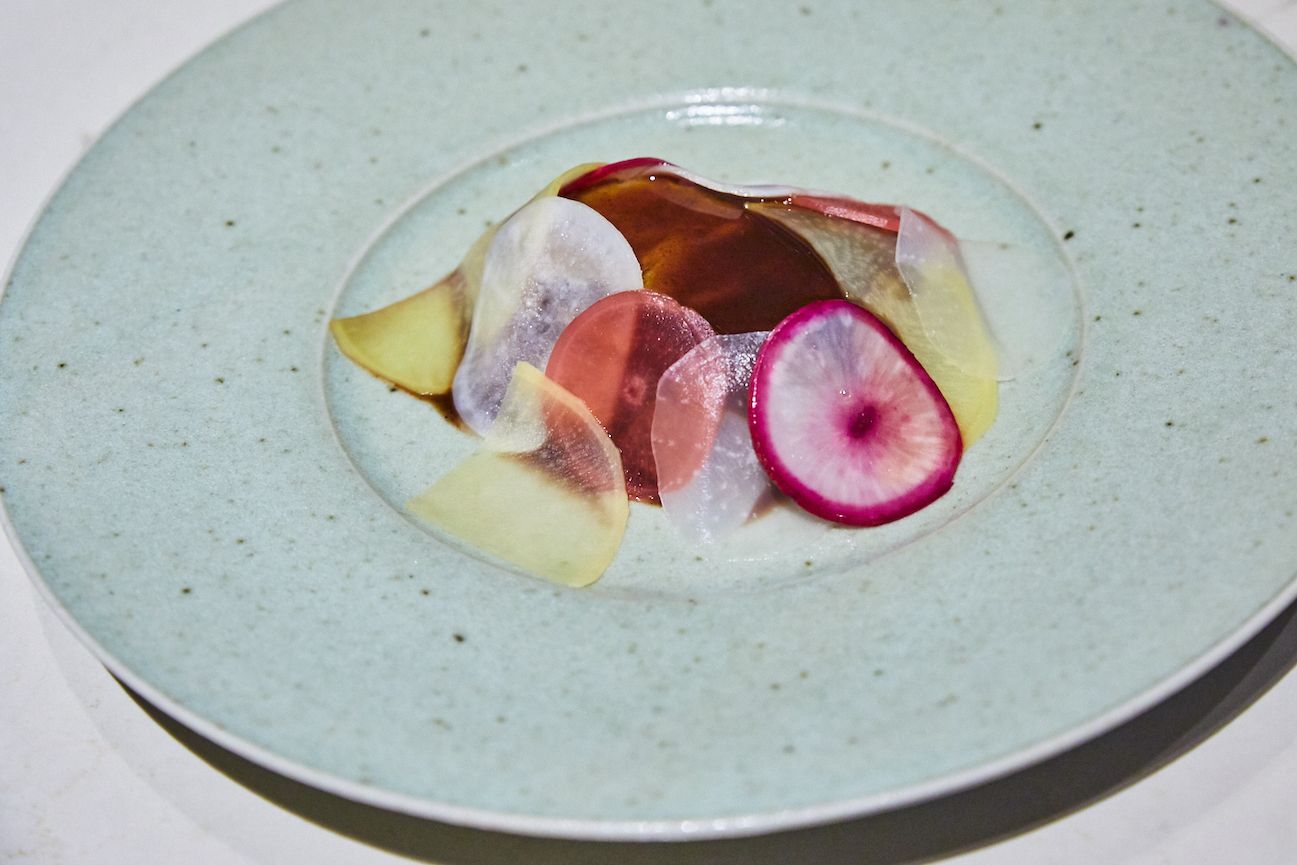
A dish of tender loin of Kumano beef from Wakayama Prefecture accompanied by the chef’s homemade Yuzu pepper and turnip.
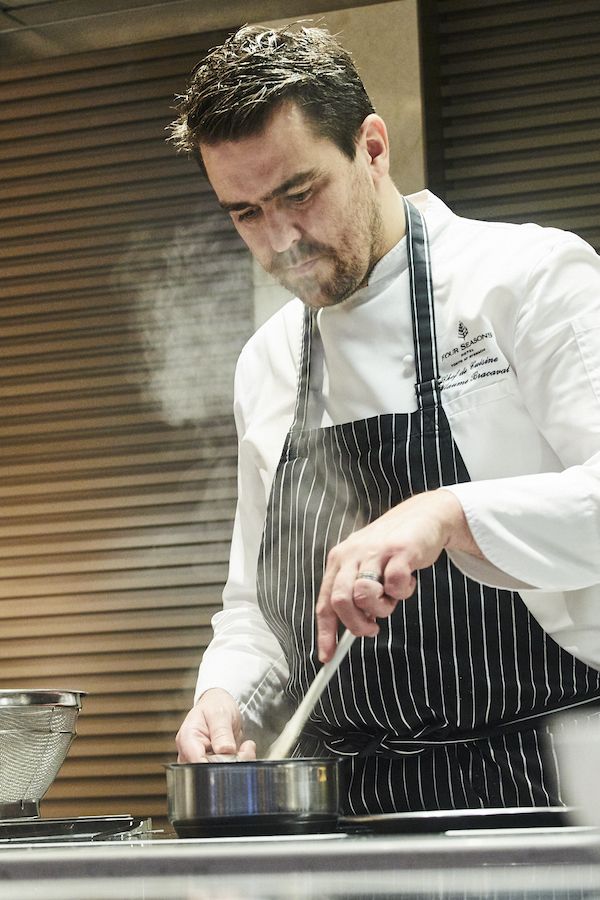
Guillaume heating the slowly simmered red wine sauce.
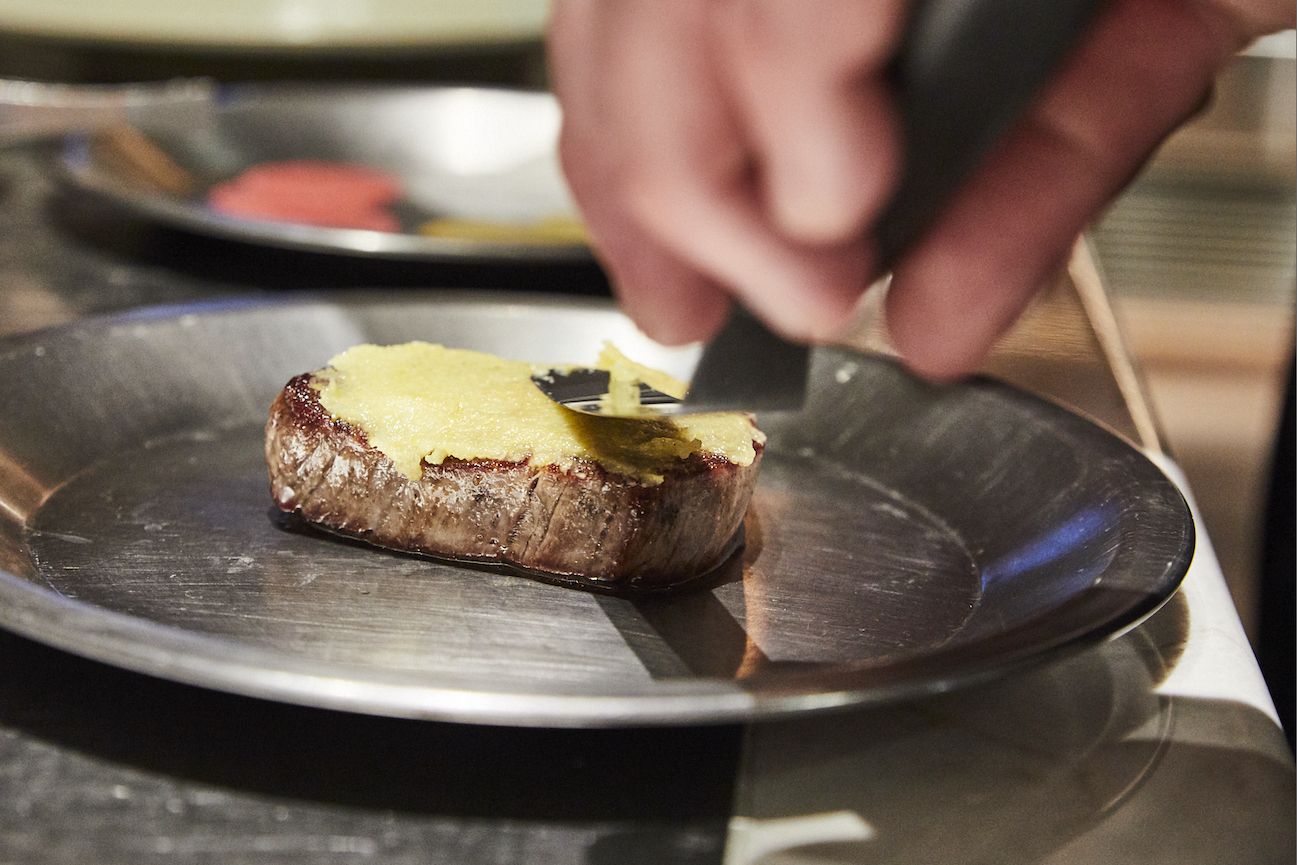
The homemade Yuzu pepper is hardly spicy at all, but has a fresh taste.
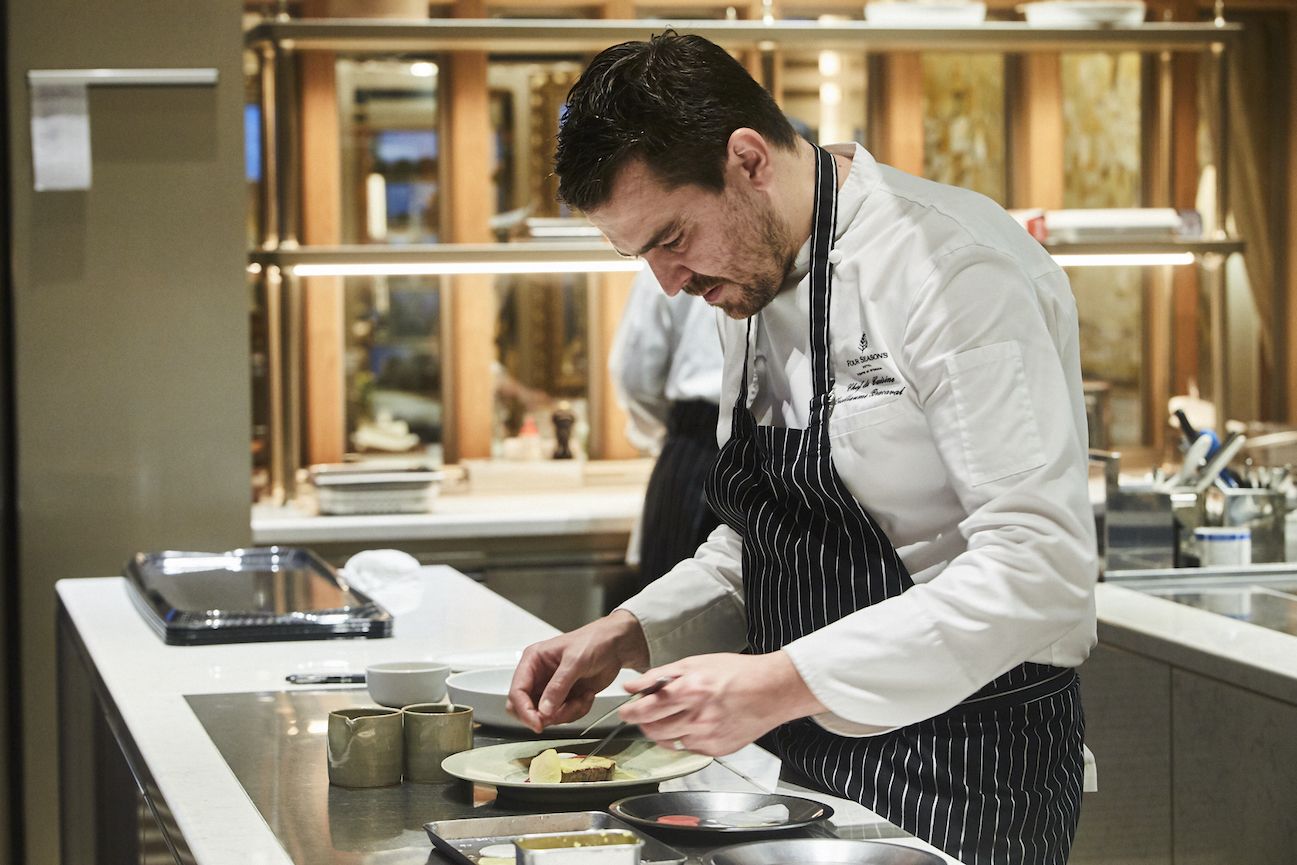
Thinly cut, colorful turnips are carefully laid out piece by piece.
“When I first started living in Japan, little by little, I researched the ingredients produced in Japan. I wondered what would happen if I interpreted ingredients produced in Japan as French cuisine. By speaking with producers and setting off on journeys, the home cooking made by my Japanese wife, and everyday small happenings, too, provide learning in themselves. It goes without saying, but I try to prioritize ingredients befitting the season, and not to overly season with salt in order to bring out the variation in subtle flavors of the Japan-grown ingredients”.
Guillaume is also excited by the many different varieties of citrus fruit that Japan can boast. He says that citrus varieties are particularly essential in his cooking that gives importance to acidity. Interested by how different citrus fruits emerge depending on the season in Japan, like sumo citrus, Yuzu, cumquat, Hyuganatsu, Ponkan orange, etc., he makes his own condiments such as Yuzu pepper and Ponzu sauce. Such a wealth of citrus varieties gives rich variation to the acidity of dishes. He pours on the finishing sauce in front of the customer as he wants them to enjoy it down to the aroma that gently floats up.
“My cooking is filled with my identity as a Frenchman, my culture, and all my experience to date. I’m sure it’s the same for Michele, who, like me, has lived in Japan for 16 years. Both my dishes and Michele’s desserts are a fusion of cultures, as well as being expressions of the ideas we want to show Japanese people”.
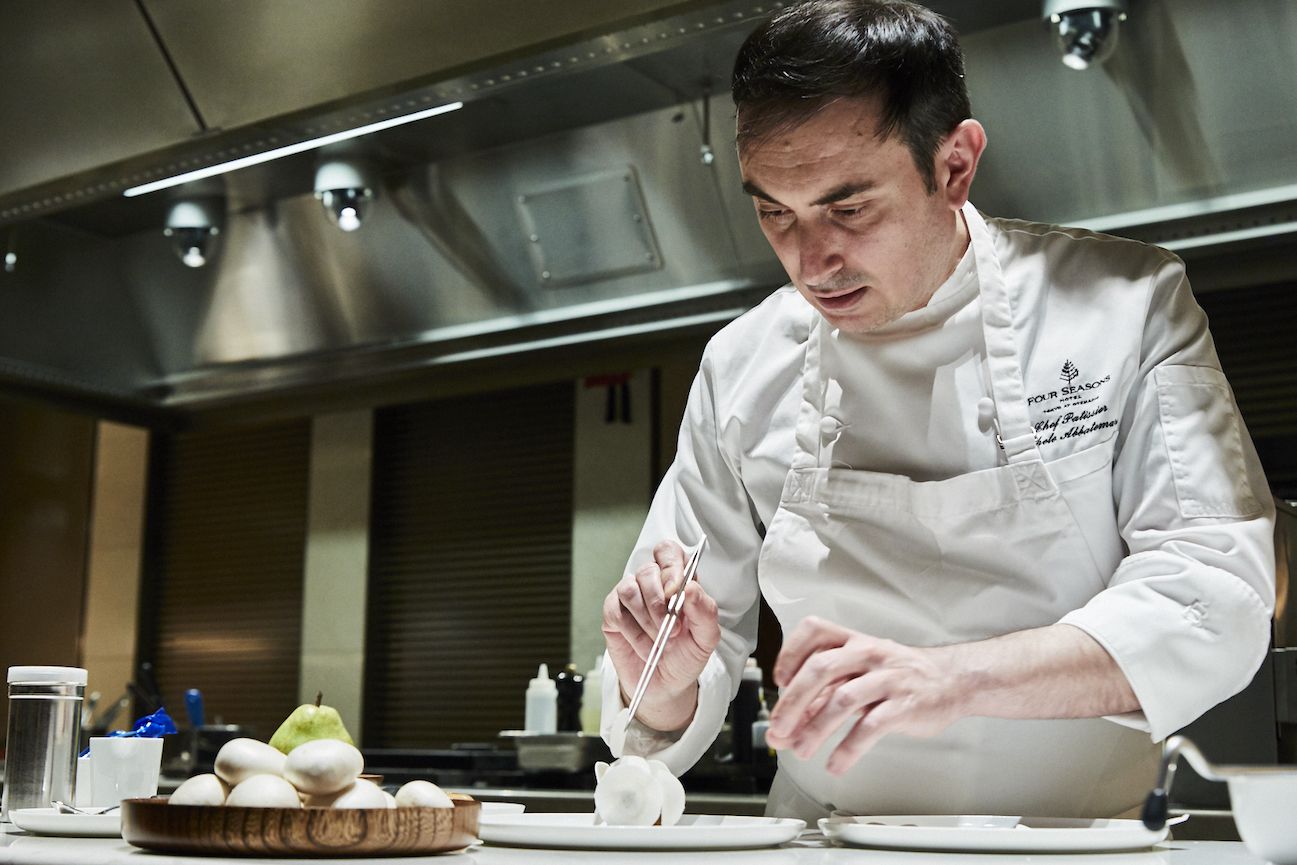
Michele decorating using pure white mushrooms like flower petals.

Desserts to bring a sigh with their beauty and delicacy. Coffee-coated pear confiture and mousse adorned with fresh mushroom slices. Served with porcini mushroom ice cream and kinoko mushroom-shaped tuiles.
Michele who is responsible for desserts makes original condiments carefully selecting vegetables and fruits of Japan.
“Like Guillaume, I take the rich variety of citrus fruits and seasonal fruits and use them as the base for desserts, such as compots, confits and semi-dried fruits. I was surprised to find that sugar, too, essential for dessert-making, comes in rich variety in Japan. With things like sugar beet, cane sugar, muscovado and refined sugar, I was excited to find sweetness that overturned my previous perceptions. I started to redesign my own recipes to fit in with their natural sweetness”.
Having discovered a delicate, plant-based sweetness also in the vegetables of Japan, Michele’s distinctive feature is his use of vegetables in desserts, too. Thinly sliced organic mushroom enwraps pear mousse like pure white petals, and the fragrance and subtle sweetness of juicy vegetables helps lock in the flavor of the rich dessert. Needless to mention the high quality of Japanese fruits, says Italian, Michele; the vegetable which has amazed him is the Japan-grown tomato.
“I came across numerous tomatoes that we don’t have in Italy. More and more new varieties of tomato are emerging, increasing the range of flavor. Also, there are very many varieties of vegetable in Japan. It is a wonder how even overseas varieties, such as artichoke, zucchini and fennel, grown in Japan have such delicate flavors.
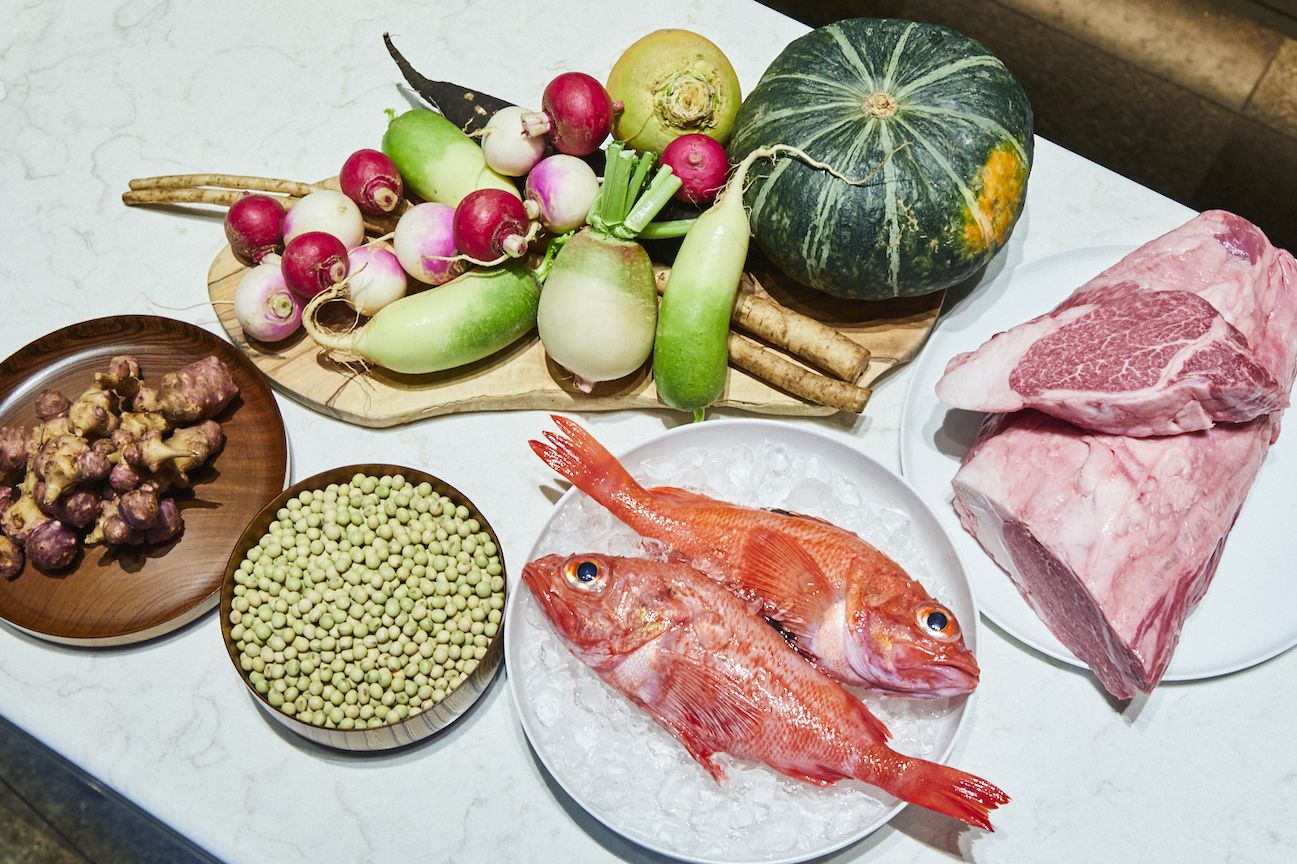
Almost everything on the menu is prepared using ingredients produced in Japan. They have a deep trust and affection for the producers, handling a diverse range of produce on a daily basis.
Both Guillaume, who was brought up on organic produce as the norm, and Michele, who has a fervent passion for produce, are both dads greatly involved in bringing up their children. In consideration of their children’s health and future, they take seriously issues like the safety of ingredients and not creating waste, and also care of the environment, so that they put their minds to preparing food where there is collaboration between savory dish and dessert.
The pair talk about the excitement of encountering unusual ingredients that even Japanese people don’t know about. “The chef’s work is also the promotion of ingredients”, they assert. On the back of the message cards to the guests laid on the tables is a map of Japan showing all their producers at a glance. Hokkaido fisheries, Akita goat milk, Chiba artichokes, Yamanashi eggs... The map even displays where in Japan the cutlery and kitchen knives used in the restaurant were made. Another surprise are the varieties of Japanese mineral water lined up on the wine list. There is an array of different brands of water - Kyoto’s “Sparkling natural mineral water from Yamazaki”, Okuaizu’s “Natural sparkling water”, etc. - well-known but to the select few, with photos of their beautiful bottles.
“You can’t cook without the raw ingredients. So, the Michelin star that the restaurant received also belongs to our producers. We want to reflect, in our dishes, all the stories of how the produce and items were nurtured”
Guillaume speaks passionately, while Michele catches his eye and nods. Every plateful is a reinterpretation of the nature, tradition, culture and seasons of Japan, and is steeped in the pair’s deep passion, never failing to amaze those who visit.
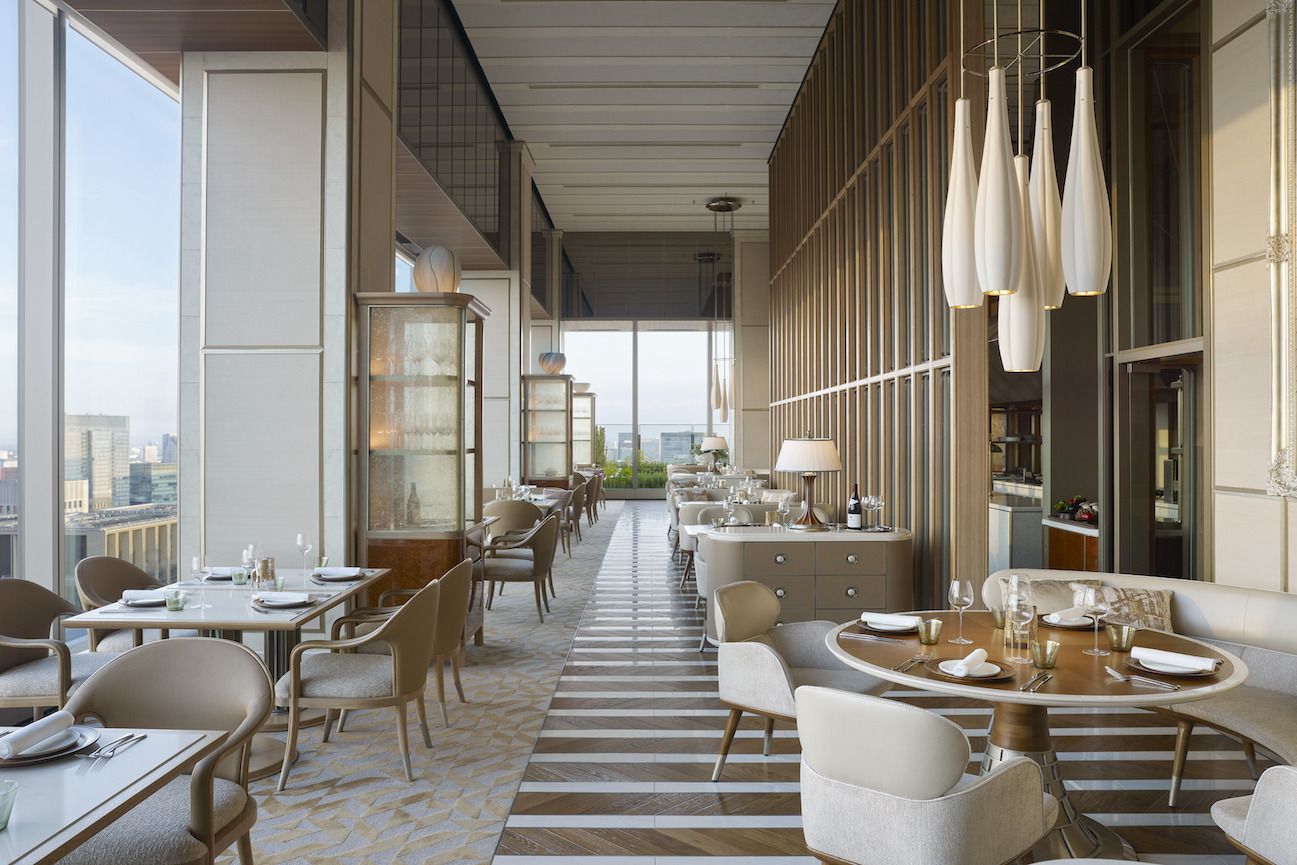
The beautiful restaurant interior with a sweeping view of the Tokyo skyline from every seat. Enabling you to forget the every day, and enjoy a sophisticated meal.
Text: Miki Suka Photography: Taro Terasawa
Guillaume Bracaval/Michele Abbatemarco
From Lesquin, France. After working at prestigious three-star restaurants in Paris such as “L'Ambroisie” and “L’Arpège”, became Executive Chef at “Cuisine[s] Michel Troisgros” Tokyo. Since 2020, employed as Chef de Cuisine at “est”, French restaurant of “Four Seasons Hotel Tokyo Otemachi”. Awarded star in Michelin Guide Tokyo 2022. He offers innovative French cuisine, putting importance on artistic consideration and showing reverence to the ingredients produced in Japan.
From Montferrat, Italy. Graduating from a culinary academy in Italy, he honed his skills at numerous well-known restaurants, including three-star restaurant “Lucas Carton” in Paris, as well as in Italy, Monaco, etc. In 2005, came to Japan as pastry chef at “Antica Osteria del Ponte” Tokyo outlet. Later, moved to “Cuisine[s] Michel Troisgros” Tokyo. Since 2020, employed as pastry chef at “est”, French restaurant of “Four Seasons Hotel Tokyo Otemachi”. He creates delicate flavors and artistic desserts decorated in minute detail.




